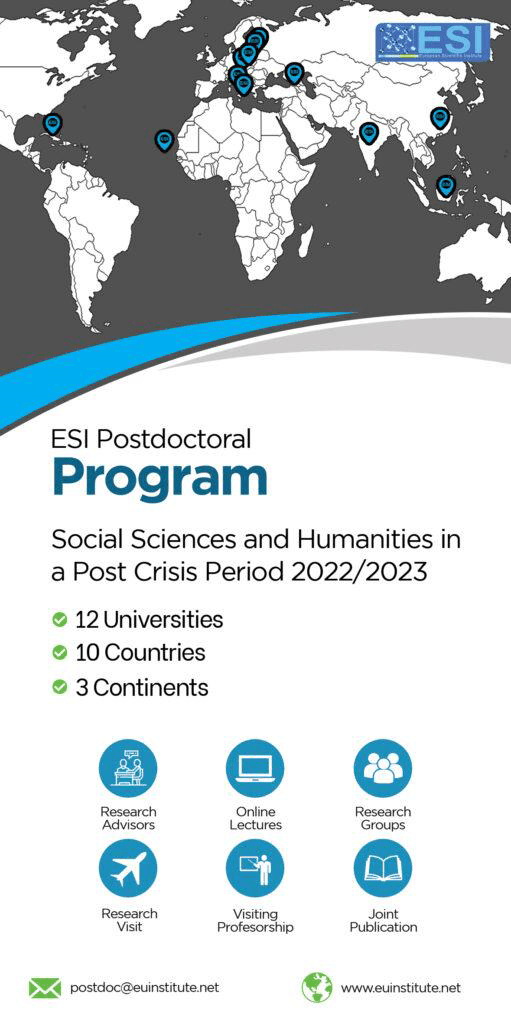Theoretical Framework for the Green Recovery Model for Forest and Farm Producer Organizations in Vietnam PostNatural Disasters: Towards Sustainable Development and Resilience Enhancement
Abstract
Green recovery is not only an immediate response to natural disasters but also a crucial strategy for strengthening the resilience of rural ecosystems and communities in the face of increasing climate change. This study proposes a theoretical framework for a green recovery model, particularly suited to forestry and agricultural organizations affected by natural disasters, with a specific focus on the case of Typhoon Yagi in Vietnam.
The analysis is based on a systematic review of the methodological literature outlined by Jesson et al. (2011), incorporating more than 40 peer-reviewed academic publications from databases such as Scopus, Web of Science, Elsevier, and Emerald. The selection process follows strict criteria to ensure data relevance and accuracy. The studies analyzed, including those by OECD (2020), UNEP (2020), Barbier (2020), and Phillips & Heilmann (2021), provide valuable insights into green recovery policies, sustainable resource management strategies, and international best practices.
The results indicate that an effective green recovery model for forestry and agricultural organizations must be built upon five fundamental pillars: (1) sustainable management of natural resources, (2) sustainability-oriented economic and financial policies, (3) technological innovation and the transition to renewable energy, (4) active community involvement and the strengthening of Forest and Farm Producer Organizations (FFPOs), and (5) circular economy development to minimize environmental impacts. Implementing such a model would not only accelerate disaster recovery but also facilitate the transition to a more resilient, low-carbon economy.
From a practical perspective, the study offers recommendations for public institutions and international organizations to integrate green recovery into long-term development strategies. In particular, it emphasizes the need to invest in green infrastructure, promote the adoption of sustainable technologies, and implement eco-certification programs to enhance the global competitiveness of FFPOs.
In conclusion, green recovery is not only a means of mitigating the impact of natural disasters but also a strategic tool for fostering sustainable and inclusive development. Further research is needed to assess the effectiveness of different green recovery strategies within specific socio-economic contexts and to refine policies that support FFPOs.
Downloads
Metrics
References
2. Agrawala, S., D. Dussaux and N. Monti (2020). “What policies for greening the crisis response and economic recovery?: Lessons learned from past green stimulus measures and implications for the COVID-19 crisis”, OECD Environment Working Papers, No. 164, OECD Publishing, Paris, https://doi.org/10.1787/c50f186f-en.
3. ASEAN. (2020). ASEAN Comprehensive Recovery Framework . https://asean.org/book/asean-comprehensive-recovery-framework/
4. Ashraf N and Van Seters J. (2021). Towards a global green recovery: The cases of Denmark, the EU, Germany, the Netherlands and the UK. European Centre for Development Policy Management (ECDPM). Available from: www.ecdpm.org/dp295.
5. Awe,Yewande Aramide. (2012). Toward a green, clean, and resilient world for all : a World Bank Group environment strategy 2012 - 2022 (English). Washington, D.C. : World BankGroup. http://documents.worldbank.org/curated/en/314021468323995788/Toward-a-green-clean-and-resilient-world-for-all-a-World-Bank-Group-environment-strategy-2012-2022.
6. Barbier, E. (2020). Building a Greener Recovery: Lessons from the Great Recession. Geneva: UNEP.164. Paris: OECD.
7. CAT Petersburg Dialogue Briefing (2020). Analysis: Green economic stimulus packages can bend the post COVID-19 emissions curve. Available from: https://climateactiontracker.org/press/analysis-green-economic-stimulus-packages-canbend-the-post-covid-19-emissions-curve/.
8. CBI. (2020). Priorities for a green recovery following the coronavirus pandemic https://www.cbi.org.uk/articles/green-recovery-prioritiesfollowing-coronavirus/;
9. Climate Support Facility CSF. (2022). Green Recovery M&E Technical Note.climatesupportfacility@worldbank.org.
10. CSIS and CIF. (2021). A Just Green Recovery from COVID-19. Just Transition Initiative. https://www.cif.org/sites/cif_enc/files/knowledge-documents/justgreenrecovery_covid19.pdf.
11. Edward B. Barbier. (2010). Toward a Global Green Recovery: The G20 and the Asia Pacific Region,” The Asia Pacific Journal 8, no. 28 (July 12, 2010), https://apjjf.org/-Edward-B.-Barbier/3383/article.html.
12. E3G (2020). Recovering Better: A Green, Equitable And Resilient Recovery From Coronavirus. Available from: https://www.e3g.org/wpcontent/uploads/27_04_20_E3G_Recover-better-briefing-note-.pdf.
13. EU Technical Expert Group on Sustainable Finance (2020). Financing a Sustainable European Economy. Technical Report. Taxonomy: Final Report of the Technical Expert Group on Sustainable Finance. Brussels: European Commission.
14. Government of Vietnam (2024). Resolution No. 143/NQ-CP dated September 17, 2024 on key tasks and solutions to urgently overcome the consequences of Typhoon No. 3 (Yagi). https://xaydungchinhsach.chinhphu.vn/.
15. Gusheva, E. and de Gooyert, V. (2021). Can We Have Our Cake and Eat It? A Review of the Debate on Green Recovery from the COVID-19 Crisis. Sustainability, 13(2) p. 874. https://doi.org/10.3390/su13020874.
16. Hepburn, C., O’Callaghan, B., Stern, N., Stiglitz, J., and Zenghelis, D. (2020). Will COVID-19 Fiscal Recovery Packages Accelerate or Retard Progress on Climate Change? Oxford Review of Economic Policy, Volume 36, Number S1, pp.S359-381.
17. IMF (2020). Greening the Recovery. IMF Fiscal Affairs Department. Washington DC: International Monetary Fund. https://www.imf.org/~/media/Files/Publications/covid19-special-notes/en-special-serieson-covid-19-greening-the-recovery.ashx?la=en.
18. Jesson, J.; Matheson, L.; Lacey, F.M. (2011). Doing Your Literature Review: Traditional and Systematic Techniques. Sage: Thousand Oaks, CA, USA, 2011.
19. Krebel et al. (2020). Building a Green Stimulus for Covid-19 https://neweconomics.org/uploads/files/green-stimulus-covid.pdf.
20. Lahcen, B., Brusselaers, J., Vrancken, K. et al. (2020). Green Recovery Policies for the COVID-19 Crisis: Modelling the Impact on the Economy and Greenhouse Gas Emissions. Environ Resource Econ 76, 731–750. https://doi.org/10.1007/s10640-020-00454-9.
21. Lamy, P. (2020). A Green Recovery Stimulus for a post-COVID-19 Europe p. 17. https://www.europejacquesdelors.eu/publications/greener-after.
22. Mölter, H., Lehne, J., Wehnert, T., Klingen, J., (2022). Summary Report of the Green Recovery Tracker: Tracking the contribution of national covid-19 recovery efforts towards a climate neutral EU. E3G & Wuppertal Institute, Berlin. https://epub.wupperinst.org/frontdoor/deliver/index/docId/7935/file/7935_Green_Recovery_Tracker.pdf.
23. O’Callaghan, B., Murdock, E and Yau, N. (2021a). Global Recovery Observatory. Draft Methodology Document.” Draft of 1st February 2021. Oxford: Oxford University Economic Recovery Project, Smith School of Enterprise and the Environment. https://recovery.smithschool.ox.ac.uk/global-recovery-observatory-draft-methodology-document/.
24. O’Callaghan, B., Kingsmill, N., Waites, F., Aylward-Mills, D., Bird, J., Roe, P., Beyer, J., Bondy, M., Aron, J., and Murdock, E (2021b). Roadmap to Green Recovery. Oxford University Economic Recovery Project.
25. O’Callaghan, B. and Murdock, E. (2021c). Are We Building Back Better: Evidence from 2020 and pathways to inclusive green recovery spending. United Nations Environment Program. https://wedocs.unep.org/bitstream/handle/20.500.11822/35281/AWBBB.pdf.
26. O’Callaghan, B., Bird, J., & Murdock, E., (2021d). A Prosperous Green Recovery for South Africa. Oxford University Economic Recovery Project, SSEE and Vivid Economics, https://recovery.smithschool.ox.ac.uk/wpcontent/uploads/2021/03/20200301_OXFORD-VIVID-_-A-Prosperous-GreenRecovery-for-South-Africa_vf_EN.pdf.
27. OECD. (2020a), Making the green recovery work for jobs, income and growth. OECD Policy Responses to Coronavirus (COVID-19), OECD Publishing, Paris, https://doi.org/10.1787/a505f3e7-en.
28. OECD. (2020b). Making the green recovery work for jobs, income and growth. Available at: https://www.oecd.org/coronavirus/policy-responses/making-the-green-recovery-workfor-jobs-income-and-growth-a505f3e7/.
29. OECD (2021). The OECD Green Recovery Database: Examining the environmental implications of COVID-19 recovery policies. OECD Policy Responses to Coronavirus (COVID-19), OECD Publishing, Paris, https://doi.org/10.1787/47ae0f0d-en.
30. Phillips, J., Heilmann, F., Reitzenstein, A. and Palmer, R. (2020). Green Recovery for Practitioners. Setting the Course towards a Sustainable, Inclusive and Resilient Transformation.” Bonn and Eschborn: GIZ. https://www.international-climate-initiative.com/PUBLICATION706-1.
31. Phillips, J. and Heilmann, F. (2021). Green Recovery for Practitioners. Examples from around the World for Building Forward Better.” Bonn and Eschborn: GIZ. https://www.adaptationcommunity.net/wp-content/uploads/2021/06/2021-06-Examples-from-around-the-World-for-Building-Forward-Better.pdf.
32. Rina Saeed Khan. (2020). As a ‘Green Stimulus’ Pakistan Sets Idled to Work Planting Trees,” Reuters, April 28, 2020. https://www.reuters.com/article/us-health-coronavirus-pakistan-trees-fea/as-a-green-stimulus-pakistan-sets-virus-idled-to-work-planting-trees-idUSKCN22A369.
33. Sauven, J., Newsom, R. & Parr, D. (2020) A Green Recovery: How we get there https://www.greenpeace.org.uk/resources/green-recoverymanifesto/.
34. Strand, J. and Toman, M. (2010). Green Stimulus, Economic Recovery and Long-Term Sustainable Development. Policy Research Working Paper 5163. https://www.researchgate.net/publication/46444052.
35. Timo Maas and Paul Lucas (2021). Global green recovery: From global narrative to international policy. PBL Publishers. https://www.researchgate.net/publication/350514142_Global_Green_Recovery_From_global_narrative_to_international_policy.
36. UNEP (2020). Green Approaches to COVID-19 Recovery: Policy Note for Parliamentarians.” Nairobi: UNEP. https://www.unep.org/resources/report/green-approaches-covid-19-recovery-policy-note-parliamentarians.
37. UNEP (2023). Emissions Gap Report 2023. Nairobi: UNEP. https://www.unep.org/resources/emissions-gap-report.
38. World Bank (2021): “From COVID-19 Crisis Recovery to Resilient Recovery. Saving Lives and Livelihoods while Supporting Green, Resilient and Inclusive Development (GRID). Development Committee. April 2021.” Washington D.C.: The World Bank. https://thedocs.worldbank.org/en/doc/9385bfef1c330ed6ed972dd9e70d0fb7-0200022021/original/DC2021-0004-Green-Resilient-final.pdf.
39. World Bank (2021). Building Back Better" in Practice: A Science-Policy Framework for a Green Economic Recovery after COVID-19 (English). Policy Research working paper,no. WPS 9528,COVID-19 (Coronavirus) Washington, D.C. : World Bank Group. http://documents.worldbank.org/curated/en/622001611844084014/Building-Back-Better-in-Practice-A-Science-Policy-Framework-for-a-Green-Economic-Recovery-after-COVID-19.
Copyright (c) 2025 Hong Hai Pham, Kim Lien Le

This work is licensed under a Creative Commons Attribution 4.0 International License.








